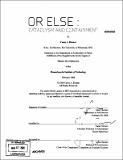| dc.contributor.advisor | Nader Tehrani. | en_US |
| dc.contributor.author | Renner, Casey A. (Casey Adam) | en_US |
| dc.contributor.other | Massachusetts Institute of Technology. Dept. of Architecture. | en_US |
| dc.date.accessioned | 2008-09-03T15:42:20Z | |
| dc.date.available | 2008-09-03T15:42:20Z | |
| dc.date.copyright | 2008 | en_US |
| dc.date.issued | 2008 | en_US |
| dc.identifier.uri | http://hdl.handle.net/1721.1/42451 | |
| dc.description | Thesis (M. Arch.)--Massachusetts Institute of Technology, Dept. of Architecture, 2008. | en_US |
| dc.description | Page 110 blank. | en_US |
| dc.description | Includes bibliographical references (p. 108-109). | en_US |
| dc.description.abstract | An analysis of the figure-ground relationships of central Minneapolis, Calgary, or Montreal must inevitably include the emergence of and pervasiveness of interior pedestrian walkways - no longer can the street/building relationship be viewed as binary or even sharing the same ground plane. The third condition, neither distinctly figure nor ground and either elevated or buried, in some ways functions as an autonomous unit detached from the city grid yet is intricately attached from building to building as climate protection. The accumulated effect of seamless sequences of corridors renders autonomous and free-standing structures obsolete. Introversion becomes de-contextual (or creates its own interior context), yet it is nevertheless a direct product of its environment as a form of retreat or protection - it is simultaneously a product of, and a removal from a harsh context. As a progressive form of urbanism, potentially allowing for increased circulation, density, and climate protection, Interior Urbanism must be considered under its own merits as a public realm and infrastructural opportunity. While traditional ideas of urban morphology inform this new situation, it is also an aberration of historical methods of city-building. This thesis is a stress-test of hermetically sealed architecture and urbanism and its inherent opportunities and limitations. If our ideas of enclosure and definition of figures pervade notions of our cities, an interior and bound condition falls victim to excessive constraints and must find a way to expand beyond its rigid confines and multiply an otherwise bounded space. This project speculates on the potential of urbanism through accumulations of multiple, localized gestures, and on opportunities to increase the seemingly limited dimension of the interior. | en_US |
| dc.description.statementofresponsibility | by Casey A. Renner. | en_US |
| dc.format.extent | 110 p. | en_US |
| dc.language.iso | eng | en_US |
| dc.publisher | Massachusetts Institute of Technology | en_US |
| dc.rights | M.I.T. theses are protected by
copyright. They may be viewed from this source for any purpose, but
reproduction or distribution in any format is prohibited without written
permission. See provided URL for inquiries about permission. | en_US |
| dc.rights.uri | http://dspace.mit.edu/handle/1721.1/7582 | en_US |
| dc.subject | Architecture. | en_US |
| dc.title | Or else : cataclysm and containment | en_US |
| dc.title.alternative | Cataclysm and containment | en_US |
| dc.type | Thesis | en_US |
| dc.description.degree | M.Arch. | en_US |
| dc.contributor.department | Massachusetts Institute of Technology. Department of Architecture | |
| dc.identifier.oclc | 239628443 | en_US |
